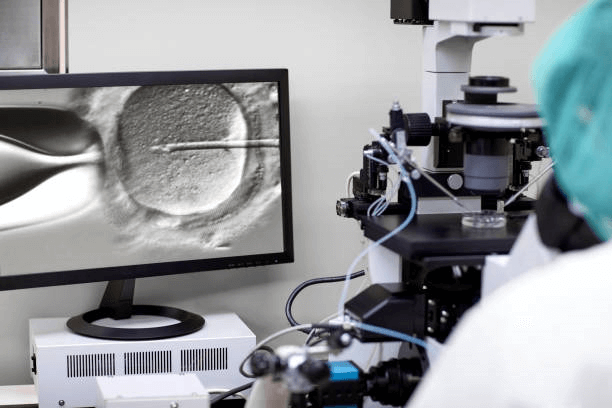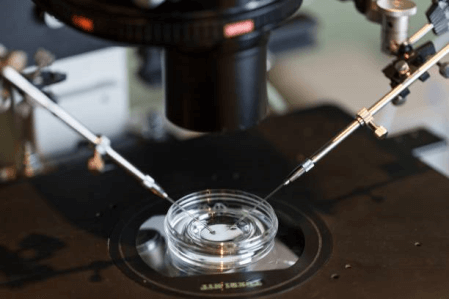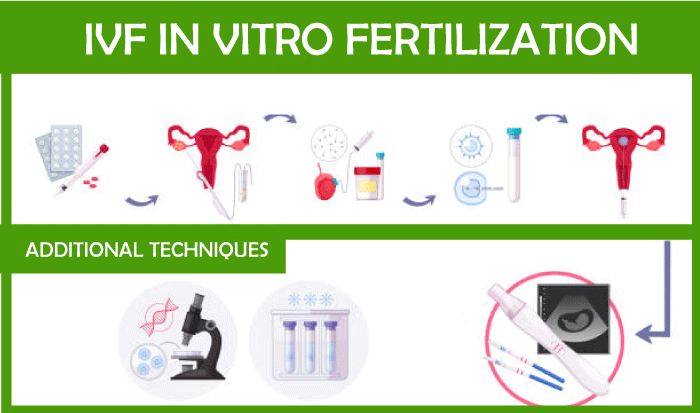Advantages and Disadvantages of IVF
IVF stands for in vitro fertilization. In vitro means fertilization outside the organism; in broad terms, we say it is a form of assisted reproductive technology. It is the treatment for infertility and gestational surrogacy. In this process, ova from the mother's ovaries and sperm of the male are fertilized under specialized conditions in the laboratory. After the egg fertilizes, it undergoes embryo culture for 2-6 days, and then it is transferred into the mother's uterus. The first baby born through IVF procedure was Louise Brown in 1978. He was a result of natural-cycle IVF that transpired at Kershaw's Cottage Hospital in Royton, England. This procedure requires high technical support and monitoring since it is sensitive. In 2018, due to heavy IVFs taking all over the world, it was estimated that nearly 8-9 million kids are to be born using in vitro fertilization procedures and other alternate reproduction techniques. It has subsequently created an opportunity for various couples/partners suffering from issues of infertility and provided them with an opportunity to experience the lather of parenthood. With the latest technological procedure, the success rate of IVF is somewhat increased but still is not as promising as required. In India, the success rate of IVF was about 55% but seeing the need and complexity of IVF the success rate must be 100%

The procedure of IVF:
- Consultation and test: The doctor will conduct tests for infertility, ovarian function, tubule patience, and hormonal balance is checked for females, and for males, semen analysis is done.
- Regulation: The doctor will prescribe hormonal medication to stop the coming menstrual cycle.
- Ovarian stimulation: another medication will be provided to stimulate the ovaries to produce multiple eggs to increase the chances of conceiving.
- Ultrasound examination: vaginal ultrasound examinations are done several times to see the result of hormonal medications.
- Injections: to trigger the final development/ maturation of eggs, hCG and GnRH injections are given to prepare the eggs for lab procedures. Usually, that happens 34-36 hours later.
- Egg collection: Transvaginal Sonography is done simultaneously; the doctor picks the eggs from the ovaries. Depending upon the responses from the injection will determine the number of eggs to be collected.
- Sperm collection: with egg collection, fresh semen is collected from the male partner/ donor (it is recommended to avoid copulation and use of any type of lubricant three to five days before this procedure to ensure the best semen sample)
- Fertilization: after picking up the sperm and ovum, the eggs are fertilized by the sperm in the laboratory through a process of in vitro fertilization. The next day an embryologist will examine the fertilization and development procedure of the embryo embryos. If multiple embryos are fertilized, they are frozen and kept for supplementary transfer if required.
- Transferring an embryo: 2-5 days after collection, the embryo will be transferred through the cervix into the uterus. After this, medications are prescribed to support the embedding phase/ luteal phase.
- Pregnancy test: after about two weeks of the transfer procedure, the doctor will do a blood test to check the pregnancy. If the test is positive, an ultrasound examination is done a week later to confirm. Otherwise, the doctor repeats the entire procedure, or in some cases, the frozen egg is repeated in the IVF cycle.

Advantages of IVF.
- IVF is bone for the parents who cannot reproduce. It works where all other treatments fail. Causes of infertility include the blocking of the fallopian tube, reduced ovarian reserves, advanced maternal age, and it can be several male infertility factors.IVF provides the best treatment by having their eggs. Many times the problem of infertility will be because of male infertility. A few techniques used in the laboratory, such as ICSI (intra- cytoplasmic sperm injection) and urologists, can also solve the problem. There are many other medications too, such, as fertility medication and intrauterine insemination, but the rate of success of IVF is more in comparison to other treatments.
- PCOS: polycystic ovary syndrome is a condition that is caused because of hormonal imbalance, which leads to irregular menstrual cycles. The success rate of patients suffering from PCOS is higher.
- Endometriosis: it is a condition in which parts of the womb lining grow outside it, which hinders normal reproduction, so in that case, IVF stands out.
- Premature ovarian failure: after a certain age, women suffer from menopause, but still, if they want to reproduce then using donor eggs, they can go for the IVF
- It has been proved that IVF has a higher success rate than IUI (intrauterine device) due to the biological advances that have created safer and secured IVFs. On the other hand, maybe for some people, IUI can be a success, but compared to IVF, presently, it's less likely to be opted for by sensitive patients. But for single women or homosexual couples, it's a viable option. IVF can also be a useful option since it provides them with an opportunity to become parents and bear a child of their own; it can be said that it's a blessing for many.
- In some cases, the cause or reason for infertility is unexplained. In that case, IVF can be used as it helps to diagnose the problem with fertilization. These cases cannot be diagnosed until and unless a fertilization procedure is attempted in the laboratory. Even though this advantage can bring disappointment but looking from the pro's side it uncovers a huge problem. It henceforth provides a solution for future treatment with ICSI (Intra cytoplasmic sperm injection). Many females have donated embryos for research, help people who need them, and even save lives. With all the legal procedures, the unused embryo can be donated to another couple, thus helping them to have a child.
- In the context of Genetic disorder carriers as parents (for example - cystic fibrosis, Huntington's disease, and muscular dystrophy), their embryo can detect or screen for any type of inherited diseases. PGD- Pre Implantation genetic diagnosis during IVF is the way through which it is ensured that the conceived child will not be suffering from the genetic disorder. PGS- Pre Implantation genetic screening during IVF will enhance the chances of a positive outcome; it screens the developing embryo for disorders that are chromosomes (for example - Down's syndrome).
In the last few decades, many couples have faced this problem of infertility due to changes in lifestyle, environment, and many more reasons; also, the success of women being cured or alternately availing opportunity through IVF have a major factor in AGE. It is very important as age is a major factor in reproduction too. The number of couples who use IVF has increased with the introduction of more and more technology. Out of every other alternate option, IVF has the maximum success rate of about 30-50%. Many myths exist in the context of IVFs that stop many more people from using this option as an opportunity to become a parent.
Disadvantages of IVF
- The major disadvantage of IVF is its success rate: it is not 100 percent guaranteed; less than 50 percent of couples who opt for IVF use it to get healthy baby birth. Sometimes it has resulted in a live birth.
- Health-related issues: the woman undergoing IVF treatment can sometimes face problems related to infection, bleeding, and anesthetic risk. OHSS(Ovarian Hyperstimulation Syndrome) is a condition where the ovaries are stimulated due to medication and injection, such as HCG (human chorionic gonadotropin), to induce ovulation. Symptoms include bloating, abdominal pain, vomiting, diarrhea, nausea, and mild abdominal pain, which can last for several weeks; sometimes severe symptoms such as weight gain and shortness of breath can also occur. This case measure happens to women undergoing IVF treatment.
- Multiple embryo transfer: many times, it has been noticed that multiple embryos are transferred, which can cause complication and leads to multiple pregnancies. This frequency of pregnancy causes serious nature of risks.
Example - In Australia, the practice of transferring only one embryo in most cases.
- High cost: the cost of IVF is very high. It starts from lakhs and can vary depending on the IVF centers. Though it is not affordable for each of us and those who try to manage are afraid of chances of failure too.
- Premature delivery: there are many cases where it has been seen that parturition occurs earlier than the usual period of 9 months which results in the premature birth of a baby with low body weight
- Miscarriage: The rate of miscarriage for the woman conceiving through IVF using embryos that have been transferred freshly is the same as that of women conceiving; naturally, that is approximately 15 to 26 percent. The rate is increasing day by day because of maternal age.
- A complication arises during the egg retrieval procedure: the needle
used for retrieving the eggs can sometimes result in bleeding or infection and damage to the bladder, blood vessels, and bowel. Sometimes risks arise due to anesthesia and sedation If used.
- Ecotopic pregnancy: in the world, 2 to 5 percent of women conceiving through IVF always have an ectopic pregnancy. It is the condition when the fertilized eggs are transferred outside the uterus, usually in the fallopian tube. If it happens, there is no chance of conceiving, and there is no way to continue the pregnancy.
- Since IVF is complicated, the additive problem or risk we can say is added to it is the mother's age; age is a crucial factor in these, and due to this, congenital disabilities chances are high in many cases Not just age, but still needs to be researched what affects the risk of being born baby IVF on the verge of congenital disabilities.
- Many studies have shown that the IVF procedure might even trigger rapid egg growth, leading to ovarian cancer. The development of these types of extra cells can be severe for the parent's health. Although these have been proven wrong in many recent studies and it's said that it mostly doesn't occur, nor any other cancer related to breast cancer, endometrial cancer, or cervical or ovarian cancer sought to occur after IVFs.
- Due to the huge technological aspects of the IVF procedure, it's rather costly and financially draining for many families. Also, it can be said that the IVF procedure causes emotional and physical stress. Support from family and friends are very vital at these stages, and very importantly, the support of the partner is necessary to go through the even odds of infertility treatment.
The Conclusion
IVF is a blessing to many; with IVF, people who are overly aged for a healthy reproduction or have infertile partners or any type of upsurge in conceiving can still have hope to bear a child, to be pregnant since it's a fact that India has seen a rapid increase in infertility rate within recent years and approximately 27.5 million couple presently are dealing with this issue. Infertility is a major problem, but as the majority of people facing it are in the middle age group, i.e., 35 years or under, due to these concerns about it have risen. But IVF facility, as known to all, is not affordable to everyone since their cost is quite high. The solution to more treatments for people suffering from infertility would be to make IVF more affordable and accessible. With this, the technology and equipment resources used in it shouldn't be compromised. Together with all these, an important factor essential in this complicated procedure would be dealing with the mental and emotional health of the patient; nowadays, because of a lack of awareness and access, people are not completely accepting IVFs as a solution to their issue. IVF centers should be better equipped to help these couples to achieve their dream of parenthood; government authorities, too, should promote and recognize infertility as a public health issue, which will impact social changes in our society.

|



 For Videos Join Our Youtube Channel: Join Now
For Videos Join Our Youtube Channel: Join Now









